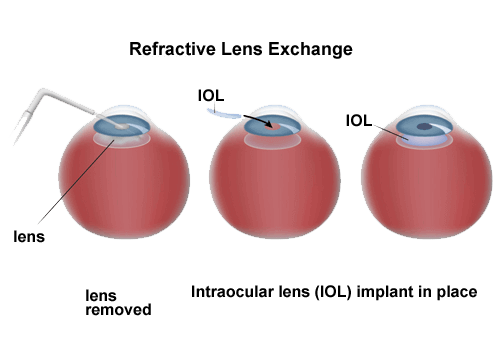
Refractive Lens Exchange is an excellent option for permanent vision correction. At Heathrow Surgery Center, our eye surgeons are proud to offer this procedure to help you attain greater visual freedom.
Refractive lens exchange, sometimes abbreviated to RLE, is a surgical procedure performed by an eye doctor that can correct your natural refractive error and provide you with greater visual freedom. The procedure involves replacing the eye’s natural lens with an artificial lens, known as an intraocular lens, or IOL.

Refractive lens exchange is an excellent option for those who require glasses or contact lenses to correct blurry vision caused by nearsightedness, farsightedness, or astigmatism. This procedure is performed on an outpatient basis and typically takes only a few minutes to complete.
Although it may take a few days for your eyes to adjust, some people experience improved vision right after the procedure. The new artificial lens that will be placed inside your eye during refractive lens exchange is made of advanced materials that are durable and resistant to clouding, providing long-lasting visual improvement.
Refractive lens exchange is a safe and effective surgical solution for those who are seeking to correct their vision and reduce their dependence on glasses or contact lenses. The procedure offers a permanent solution for improved visual clarity.

Refractive Lens Exchange can be a great option for those interested in achieving visual freedom, but not everyone is an eligible candidate for this procedure. A good candidate for refractive lens exchange is someone who experiences difficulty seeing things clearly, whether up close or from a distance.
For instance, refractive lens exchange might be a good option if you have trouble reading a book or seeing road signs while driving. Typically, refractive lens exchange is recommended for people who are over the age of forty.
However, as long as you are over twenty-one, you may be able to qualify for this procedure. Those who are over the age of forty and have trouble reading or seeing up close may have the age-related eye condition called presbyopia.
Presbyopia occurs when the lens of the eye loses some of its flexibility, reducing the ability to accommodate at different distances. Refractive lens exchange can eliminate presbyopia and allow you to see well at near again, depending on which lens you choose.
If you have certain eye conditions, such as glaucoma or a cataract, refractive lens exchange may not be the right choice for you. In order to determine if you may be a good client for refractive lens exchange, you will need to visit your eye doctor for an evaluation.
Your eye doctor will assess your eligibility for the procedure and determine if there is a better alternative for your needs.
The goal of refractive lens exchange is to restore distance and near vision with greatly reduced dependence on glasses. Typically, a multifocal Lens is placed in the eye, which represents the latest development in lens technology.
These lenses can simultaneously focus light from far away and near objects. This allows people to not only significantly reduce their dependence on glasses for far-away vision but also for reading.
Another benefit of the refractive lens exchange procedure, when compared to other refractive procedures, is that it does not alter the shape of the cornea, and it prevents the formation of cataracts. Since the entire lens is removed during refractive lens exchange, your new artificial lens will not cloud over as it would with age in a natural lens.
Unfortunately, refractive lens exchange cannot fix problems and restore vision loss due to other eye conditions like glaucoma, macular degeneration, or irregular astigmatism.
During the procedure, your eye surgeon will make a small incision in the eye’s cornea after numbing it with eye drops. Next, they will remove the natural lens and then replace it with the IOL.
Prior to the refractive lens exchange procedure, your eye doctor will help you determine which IOL is best for you depending on your vision goals and lifestyle. The procedure typically takes about thirty minutes to an hour to complete.
It is important to note that refractive lens exchange is a permanent procedure. However, the IOL can be replaced if necessary.
The success rate for refractive lens exchange is very high, and most patients achieve significant improvement in their vision.
After the refractive lens exchange procedure, you will need to rest for a few days, and you may need to use eye drops to help prevent infection and inflammation. Some people may experience some mild discomfort like burning or itching and blurred vision for a few days after the procedure, but these symptoms usually resolve within a week.
Most people are able to return to their normal activities and work within a few days, but it’s recommended to avoid rigorous activity for at least one week. Your eye doctor will provide care instructions, including when to use makeup and how to clean the eye.
Follow-up appointments will be scheduled to track recovery and ensure optimal vision. To have a successful recovery from the refractive lens exchange procedure, it’s crucial to follow the instructions given by the eye doctor and attend all follow-up appointments.
In some cases, additional vision correction methods may be required, such as glasses or contact lenses, for the best possible vision outcome. By following the recovery instructions provided to you by your eye doctor, you can achieve the full benefits of refractive lens exchange surgery.
Are you interested in learning more about refractive lens exchange? Contactus at Heathrow Surgery Center!
